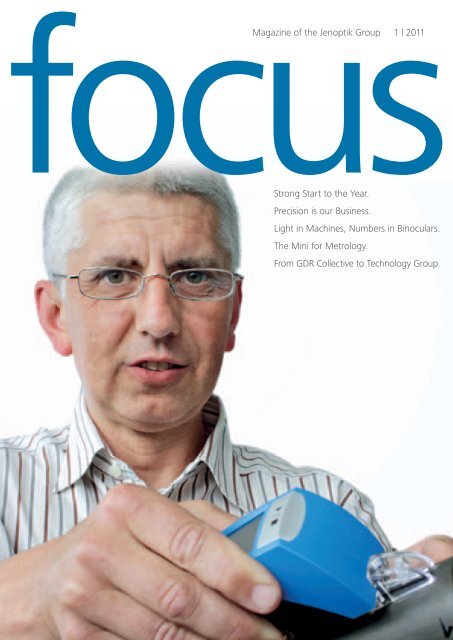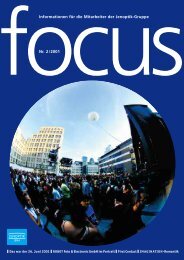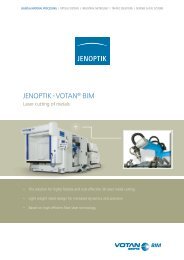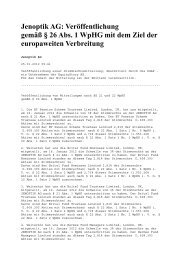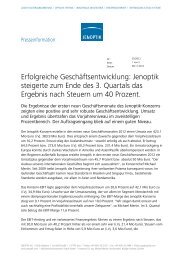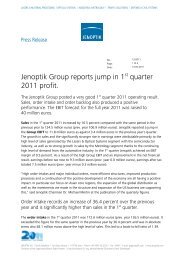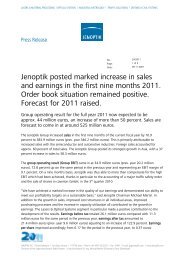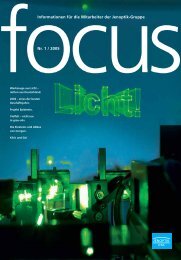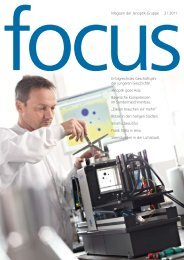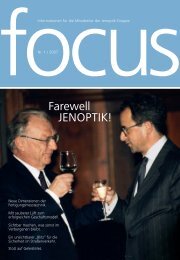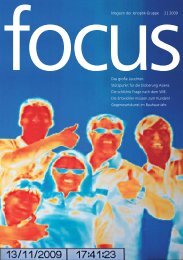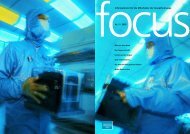1/2011 - Jenoptik AG
1/2011 - Jenoptik AG
1/2011 - Jenoptik AG
Create successful ePaper yourself
Turn your PDF publications into a flip-book with our unique Google optimized e-Paper software.
focus<br />
Magazine of the <strong>Jenoptik</strong> Group 1 l <strong>2011</strong><br />
Strong Start to the Year.<br />
Precision is our Business.<br />
Light in Machines, Numbers in Binoculars.<br />
The Mini for Metrology.<br />
From GDR Collective to Technology Group.<br />
1
Content<br />
Strong Start to the Year.<br />
After the successful fiscal year of 2010,<br />
<strong>Jenoptik</strong> closed the best first quarter in<br />
the company’s recent history with the<br />
1st quarter of <strong>2011</strong>.<br />
4 8 12<br />
Precision is our Business.<br />
The two <strong>Jenoptik</strong> divisions Industrial<br />
Metrology and Traffic Solutions are<br />
represented in Switzerland. Both focus<br />
on precise measurement.<br />
Light in Machines,<br />
Numbers in Binoculars.<br />
<strong>Jenoptik</strong> expands its product range<br />
of LEDs and increasingly offers final<br />
products for industrial customers.<br />
The Mini for Metrology.<br />
The Industrial Metrology division has<br />
launched a powerful mini-device for<br />
roughness measurement, the Hommel-<br />
Etamic W5.<br />
LEGAL NOTICE<br />
Publisher:<br />
JENOPTIK <strong>AG</strong>,<br />
Public Relations,<br />
D-07739 Jena,<br />
Phone +49(0)3641 65-2255,<br />
Fax +49(0)3641 65-2484<br />
Responsible: Katrin Lauterbach<br />
Editors: Katrin Lauterbach, Silvia Scharlock<br />
Editorial assistance:<br />
Jana Dichelle, Cornelia Ehrler<br />
2 3<br />
16<br />
From GDR Collective to<br />
Technology Group.<br />
18<br />
Twenty years ago, the foundation for<br />
today’s globally active <strong>Jenoptik</strong> was laid.<br />
A look back.<br />
Pictures:<br />
<strong>Jenoptik</strong><br />
Torsten Proß (page 3 right, page 20)<br />
SPECTARIS (page 15)<br />
fotolia.com (pages 8, 9, 11, 18/19, 22)<br />
Layout: Bernd Adam, Jena<br />
Print: Druckhaus Gera GmbH<br />
The contents of this magazine address men<br />
and women equally. For better readibility, the<br />
masculine forms are used normally.<br />
Publication in: June <strong>2011</strong>.
Katrin Lauterbach<br />
The restructuring of the last few years in all areas of the Group are<br />
now starting to pay off. At the same time, important target industries<br />
continued to develop positively. The <strong>Jenoptik</strong> Group recorded a jump<br />
in the Group EBIT of 11.8 million euros in the 1st quarter of <strong>2011</strong>.<br />
Strong Start to the Year:<br />
In <strong>2011</strong> <strong>Jenoptik</strong> recorded its best first quarter<br />
in the company’s recent history.<br />
”We expect this year to be the strongest for operating earnings<br />
since the disposal of M+W Zander five years ago. The quality of<br />
results is proof that we can reach our long-term profitability<br />
objectives,” says <strong>Jenoptik</strong> Chairman Dr. Michael Mertin of the<br />
quarterly figures published mid-May of this year. Just a few days<br />
earlier, <strong>Jenoptik</strong> had raised its forecast for Group EBIT for the<br />
full year from, originally, more than 35 million euros to the<br />
40 million euros now planned. ”We intensively discussed future<br />
business performance with our segments in extensive strategy<br />
meetings,” says Michael Mertin on the forecast increase.<br />
This increase was made based on the discussions and due to<br />
the very good order and earnings development in the 1st quarter<br />
of <strong>2011</strong>. Group EBIT of 40 million euros is an increase of more<br />
than 35 percent over the comparable figure for 2010, which<br />
was at 29.0 million euros. From as early as 2010, <strong>Jenoptik</strong> had<br />
benefited from the sustained and rapid recovery in its two<br />
main target industries, the semiconductor and the automotive<br />
industries. This trend continued during the first months of <strong>2011</strong>.<br />
For <strong>Jenoptik</strong>, the Group EBIT in the 1st quarter of 11.8 million<br />
euros primarily reflects the currently very high level in the<br />
semiconductor cycle. ”You are no prophet if you forecast a<br />
normalization during the course of the year,” says Michael<br />
Mertin. He also cautioned that the quarterly EBIT of 11.8 million<br />
euros could not be extrapolated one-to-one for the entire fiscal<br />
year.<br />
Sales and employment growth,<br />
especially abroad.<br />
In <strong>2011</strong>, sales are expected to rise from 478.8 million euros in<br />
2010 (without Jena-Optronik GmbH) to more than 510 million<br />
euros. Strong sales are anticipated in the Lasers & Optical<br />
Systems and Metrology segments in <strong>2011</strong>. Both segments were<br />
already sales drivers in the 1st quarter of <strong>2011</strong>, in which sales<br />
increased by 16.5 percent over the prior year’s quarter to<br />
124.5 million euros.<br />
In both 2010 as well as the 1 st quarter of <strong>2011</strong>, sales<br />
growth came primarily from abroad. For instance, sales<br />
in North America (NAFTA) rose by just under 15 percent<br />
in the 1st quarter of <strong>2011</strong> and by almost 52 percent in<br />
Asia. In Europe, sales volumes also increased by more<br />
than 40 percent compared to the same period last year<br />
due to the booming semiconductor industry, while<br />
sales in Germany declined slightly. <strong>Jenoptik</strong> is present<br />
in more than 70 countries and is focusing on future<br />
growth primarily through further internationalization.<br />
The key target areas are North America and Asia. So,<br />
after <strong>Jenoptik</strong> Korea in 2009, another majority stake<br />
was established in Asia in 2010 – <strong>Jenoptik</strong> Japan. In the<br />
USA, <strong>Jenoptik</strong> has invested in new production equipment<br />
at its Optics locations.<br />
”Considering the sales trend abroad, we will primarily<br />
recruit new employees also in those regions,” summarized<br />
Michael Mertin regarding questions on a planned<br />
rise in employees in Germany. ”Our German sites will<br />
also grow, but probably not as rapidly as overseas.”<br />
Overall, the workforce should rise slightly in <strong>2011</strong>, but<br />
not analogous to the increase in sales. This trend has<br />
already underpinned the development of the 1st quarter<br />
of <strong>2011</strong>: Consolidated sales rose by 16.5 percent with<br />
an almost constant workforce of 2,956.<br />
The fiscal year of 2010 at a glance<br />
Continuing BD Change comp.<br />
(Figures in million euros) 2010 Group 2) 2010 Group 2009 to Group in %<br />
Sales 478.8 510.6 473.6 7.8<br />
Lasers & Optical Systems 188.9 188.9 166.7 13.3<br />
Metrology 113.8 113.8 96.0 18.5<br />
Defense & Civil Systems 173.9 205.8 205.3 0.2<br />
Others 1) 2.2 2.1 5.6 – 62.5<br />
EBIT 29.0 56.4 – 19.6 ++<br />
Lasers & Optical Systems 13.3 13.3 – 16.5 ++<br />
Metrology 8.6 8.6 – 14.6 ++<br />
Defense & Civil Systems 8.6 11.5 12.2 – 5.7<br />
Others 1) – 1.5 23.0 – 0.7 ++<br />
Earnings before tax 15.0 42.5 – 34.3 ++<br />
Earnings after tax 9.0 36.4 – 33.9 ++<br />
Order intake 534.6 582.5 432.8 34.6<br />
Lasers & Optical Systems 230.2 230.2 168.4 36.7<br />
Metrology 137.0 137.0 83.2 64.7<br />
Defense & Civil Systems 163.7 211.6 178.0 18.9<br />
Others 1) 3.7 3.7 3.2 15.6<br />
Continuing BD Group without Optronik Change<br />
(Figures in million euros) at 31.12.2010 at 31.12.2009 in %<br />
Order backlog 355.4 304.0 16.9<br />
Lasers & Optical Systems 98.8 59.9 64.9<br />
Metrology 45.1 21.9 105.9<br />
Defense & Civil Systems 212.6 224.8 – 5.4<br />
Others 1) – 1.1 – 2.6 57.7<br />
Employees (31.12. incl. trainees) 2,951 3,138 – 6.0<br />
Lasers & Optical Systems 1,234 1,184 – 3.9<br />
Metrology 632 769 – 17.8<br />
Defense & Civil Systems 931 947 – 1.7<br />
Others 1) 154 138 11.6<br />
1) Others includes holding, SSC, real-estate, consolidation.<br />
2) Group with Jena-Optronik GmbH.<br />
BD = Business Division<br />
4 5
<strong>Jenoptik</strong> in Japan.<br />
In November 2010, <strong>Jenoptik</strong> expanded its presence<br />
in Japan together with longtime partner Kantum<br />
Electronics Co. Ltd. The joint venture by <strong>Jenoptik</strong> and<br />
Kantum, founded in 2005 and specializing mainly in<br />
the sale of diode lasers, is now called JENOPTIK Japan<br />
Co. Ltd and is open to all Group divisions. Sales was<br />
extended to other Group products and <strong>Jenoptik</strong> has<br />
since become the majority shareholder with an almost<br />
two-thirds majority.<br />
All <strong>Jenoptik</strong> employees and their families survived the<br />
terrible earthquake in Japan without health consequences.<br />
The business premises also remained intact.<br />
A crisis committee was established where, to this day,<br />
all information is brought together. ”Our Japan business<br />
is still in its infancy. In 2010, it amounted to about<br />
1 percent of sales,” says <strong>Jenoptik</strong> Chairman Michael<br />
Mertin. The procurement volume from Japan was<br />
slightly more than 1 percent of the Group’s total<br />
volume in 2010 so, even here, no large direct effects<br />
are expected and also did not occur until May.<br />
”It remains to be seen how the situation will evolve<br />
and we will constantly evaluate what is guaranteed by<br />
our central procurement management,” says Michael<br />
Mertin.<br />
Sale of Jena-Optronik GmbH.<br />
As part of the consolidation of the European space<br />
market, in December 2010 <strong>Jenoptik</strong> sold all shares of<br />
the subsidiary Jena-Optronik GmbH to Astrium GmbH,<br />
an EADS Group company. The <strong>Jenoptik</strong> Group’s space<br />
business was bundled in Jena-Optronik GmbH, which<br />
contributed about 30 million euros to sales of the<br />
<strong>Jenoptik</strong> Group. <strong>Jenoptik</strong> acquired a majority holding<br />
of Jena-Optronik GmbH in 2003 and increased the<br />
share to 100 percent in 2004. The business was<br />
expanded and Jena-Optronik developed into a world<br />
market leader in specialized areas of satellite<br />
technology while the company’s sales had nearly<br />
doubled since then. “For Jena-Optronik GmbH, we<br />
expect better growth opportunities in the future<br />
through being part of a global system supplier and<br />
specialists in aerospace such as EADS,” says Michael<br />
Mertin. The <strong>Jenoptik</strong> Group used the cash inflow after<br />
conclusion of the sale in December 2010 to significantly<br />
reduce net debt.<br />
A sound financial position:<br />
Net debt now “only” 73.5 million euros.<br />
In 2010, the key figures of the <strong>Jenoptik</strong> Group were chiefly defined by the<br />
sale of Jena-Optronik GmbH. Group EBIT, in particular, was positively<br />
impacted by the sale proceeds. This was 56.4 million euros, including the<br />
one-off effects of the sale. The sale – in addition to the positive cash flow<br />
resulting from consistent receivables and inventory management and the<br />
capital increase in March 2010 – also contributed to a halving of net debt to<br />
79.3 million euros at the end of <strong>2011</strong> (159.5 million euros at the end of<br />
2009). In the 1st quarter of <strong>2011</strong>, it fell again by 7.3 percent to 73.5 million<br />
euros. ”We have worked intensely on this key company figure for financial<br />
stability in the past two years,” says Chief Financial Officer Frank Einhellinger.<br />
“Our focus on positive cash flows has particularly proven itself,” summarized<br />
the CFO. The main driver is Working Capital Management with the objective<br />
of “tieing up” the least amount of financial resources possible – whether in<br />
production material in the Group’s storerooms or as products or processed<br />
products not yet with the customer. This requires efficient processes in order<br />
to reduce storage and processing times. “We are working on this in many of<br />
our <strong>Jenoptik</strong> Excellence Program projects, which went into its third year in<br />
<strong>2011</strong> with projects in all areas of the Group,” says Frank Einhellinger.<br />
Increase in sales by region<br />
NAFTA<br />
16.9m euros<br />
(+14.9 %)<br />
Europe<br />
42.9m euros<br />
(+40.3 %)<br />
Order situation remains positive.<br />
Germany<br />
48.9m euros<br />
(–0.9 %)<br />
Others<br />
4.5m euros<br />
(–8.5 %)<br />
In 2010, the <strong>Jenoptik</strong> Group was able to report order intakes that were about<br />
23 percent higher than 2009. The strong growth to 534.6 million euros<br />
(previous year, 432.8 million euros) resulted from the economic recovery as<br />
well as several large orders that <strong>Jenoptik</strong> was able to book. These included<br />
an order for medical lasers in the USA, a large order from abroad for traffic<br />
Asia<br />
12.2m euros<br />
(+51.6 %)<br />
The growth in Group sales by 16.5 percent in the 1 st quarter of <strong>2011</strong> came completely from abroad.<br />
solutions technology, as well as the order for the next tranche<br />
of Eurofighter Radom and the energy supply for PATRIOT<br />
anti-missile systems in the Defense & Civil Systems division.<br />
Both trends continued in the first months of the current fiscal<br />
year – a good economic situation with overall high order<br />
intakes, especially from the semiconductor and automotive<br />
industries, as well as the aforementioned large orders on top.<br />
In the 1 st quarter of <strong>2011</strong>, order intake was 172.6 million euros,<br />
surpassing the prior year’s quarter by 36.4 percent. Included is<br />
the large partial order for the PUMA armored fighting vehicle<br />
at just under 40 million euros in the Defense & Civil Systems<br />
segment. Another large partial order for the PUMA is expected<br />
in the coming months. In May, <strong>Jenoptik</strong> was able to announce a<br />
large order of more than 20 million euros from Saudi Arabia in<br />
the Traffic Solutions division, which will also impact on the order<br />
intake in the current 2nd quarter of <strong>2011</strong>. Several hundred stationary<br />
systems for recording red light and speed violations will<br />
be delivered and installed through this year and the next. As a<br />
result, the order will in part contribute to sales and earnings in<br />
<strong>2011</strong>.<br />
Long-term goals remain.<br />
”Above all, the order development of recent months and the<br />
continuing strong economy are encouraging for the whole of<br />
<strong>2011</strong>,” concludes Michael Mertin. Although the very good 1st quarter for <strong>Jenoptik</strong> reflects the currently very high level in the<br />
semiconductor cycle and management is anticipating a normalization<br />
during the course of the year, the automotive industry,<br />
medical technology, photovoltaics and the transport and<br />
security areas are further drivers of the expected positive<br />
development beyond <strong>2011</strong>. “Our earnings in the 1st quarter of<br />
<strong>2011</strong>, with an EBIT margin of 9.5 percent, shows that we can<br />
achieve our medium-term profitability targets – a Group-wide<br />
EBIT margin of 9 to 10 percent,” says Michael Mertin.<br />
”We don’t want to grow at all costs, but profitably while<br />
maintaining intrinsic value,” comments the <strong>Jenoptik</strong> Chairman<br />
on questions of possible acquisitions. Acquisitions have to move<br />
us forward, be it on the market, technology or product side or<br />
in a specific region. The financial resources resulting from the<br />
measures in 2010 and the continued positive cash flow from<br />
operating activities open attractive opportunities for organizational<br />
growth and acquisitions.<br />
The months January until March at a glance<br />
Group Group 2) Change<br />
(Figures in million euros) Jan.–March <strong>2011</strong> Jan.–March 2010 in %<br />
Sales 124.5 115.2 16.5<br />
Lasers & Optical Systems 56.1 45.2 24.1<br />
Metrology 28.0 20.0 40.0<br />
Defense & Civil Systems 40.0 49.9 – 3.8<br />
Others 1) 0.4 0.1 ++<br />
EBIT 11.8 4.0 ++<br />
Lasers & Optical Systems 10.2 3.9 ++<br />
Metrology 1.0 – 1.0 ++<br />
Defense & Civil Systems 1.1 1.7 10.0<br />
Others 1) – 0.5 – 0.6 0<br />
Earnings before tax 9.3 0.7 ++<br />
Earnings after tax 7.5 0.4 ++<br />
Order intake 172.6 145.6 36.4<br />
Lasers & Optical Systems 61.1 56.2 8.7<br />
Metrology 38.0 40.4 – 5.9<br />
Defense & Civil Systems 73.7 48.8 148.1<br />
Others 1) – 0.2 0.2 ++<br />
Group Group 2) Change<br />
(Figures in million euros) March 31, <strong>2011</strong> Dec. 31, 2010 in %<br />
Order backlog 398.1 355.4 12.0<br />
Lasers & Optical Systems 101.6 98.8 2.8<br />
Metrology 51.9 45.1 15.1<br />
Defense & Civil Systems 246.4 212.6 15.9<br />
Others 1) – 1.8 – 1.1 ++<br />
Employees (incl. trainees) 2,956 2,951 0.2<br />
Lasers & Optical Systems 1,240 1,234 0.5<br />
Metrology 633 632 0.2<br />
Defense & Civil Systems 930 931 – 0.1<br />
Others 1) 153 154 – 0.6<br />
1) Others includes holding, SSC, real-estate, consolidation.<br />
2) Group without Jena-Optronik GmbH<br />
Note: For the <strong>2011</strong> financial reporting all Jena-Optronik GmbH key figures have been excluded<br />
for 2010 so that the <strong>2011</strong> figures are fully comparable with those of 2010.<br />
On the question of the distribution of a dividend, Michael<br />
Mertin explains: ”Solid equity capital is vital for sustainable<br />
growth, particularly for technology companies.” In addition to<br />
replacing existing financing, future dividends would also depend<br />
on the extent to which <strong>Jenoptik</strong>’s liquidity could be sensibly<br />
invested in growth and acquisitions. ”However, we obviously<br />
want to reach a position where we are able to pay dividends,”<br />
says the <strong>Jenoptik</strong> Chairman.<br />
www.jenoptik.com<br />
katrin.lauterbach@jenoptik.com<br />
6<br />
7
Cornelia Ehrler<br />
Switzerland stands for much that is characterized by quality,<br />
taste and tradition. Just think of culinary delights such as Swiss<br />
cheese, raclette and rosti. Or Swiss chocolate – many pioneers<br />
of chocolate production were located in Switzerland, such as<br />
Rodolphe Lindt, inventor of “conching”, which makes chocolate<br />
creamy; Philippe Suchard, inventor of the “Milka” brand, and<br />
Theodor Tobler, who invented ”Toblerone” in 1908 and which<br />
is still produced exclusively in Bern, the Swiss capital.<br />
Switzerland is eponymous for landscapes reminiscent of rocky<br />
or sandy mountains and lakes. In Germany alone there are more<br />
than 60 of these Swiss landscapes such as Saxon Switzerland,<br />
with the Elbe Sandstone Mountains.<br />
Switzerland also stands for money. According to statistics from<br />
the International Monetary Fund, the Alpine country regularly<br />
belongs to the five wealthiest countries in the world according<br />
to its gross domestic product per capita. In the “Global Competitiveness<br />
Index 2010 – <strong>2011</strong>” at the Geneva World Economic<br />
Forum, which evaluates the competitiveness of a country,<br />
Switzerland is once again in first place, followed by Sweden,<br />
Singapore, the United States – and Germany in fifth place.<br />
Precision<br />
Switzerland is different, but neutral.<br />
Switzerland seems to be different, a special case in the middle<br />
of Europe. A country with four official languages, including<br />
Rhaeto-Romanic, spoken by only 0.5 percent of the population<br />
in the canton of Grisons. Politically, too, Switzerland is different,<br />
as the history of the Confederates, marked by wars and myths<br />
surrounding the autonomy of the cantons, such as the Rütlischwur<br />
(Rütli oath), gave rise to a unique political formation.<br />
Founded as a loose confederation of states, the current federal<br />
state with the official designation of ”Swiss Confederation”<br />
differs from other republics worldwide. The 26 cantons are<br />
living a distinctive federalism. Citizens have a direct influence on<br />
government action through elements of direct democracy such<br />
as referendums and initiatives. And the “perpetually armed”<br />
neutrality in foreign policy is a constitutional principle, which<br />
excludes membership in military alliances such as NATO.<br />
Despite this, Switzerland has an army, no, Switzerland is an army,<br />
as the saying goes. Although only five percent of Army personnel<br />
are regular soldiers, the rest are conscripts, but they keep their<br />
personal equipment, including weapon, at home. Swiss citizens<br />
are prohibited from serving in a foreign army. The exception is the<br />
Swiss Guard which has been responsible since 1506 for the<br />
protection of the Pope as ”house police” – not as an army.<br />
Switzerland is known for utmost precision. No wonder<br />
that two <strong>Jenoptik</strong> divisions, which are both very precise,<br />
are represented in the Confederation: Industrial Metrology<br />
with Hommel-Movomatic Suisse SA and Traffic Solutions<br />
with Multanova <strong>AG</strong>.<br />
is our Business.<br />
The Swiss government, the Federal Council with seven members, is tradition-<br />
ally regarded as the most stable executive authority in the world. Equally<br />
reliable are the conditions for foreign employers who appreciate the high<br />
productivity and excellent infrastructure in Switzerland. Some 1,200 German<br />
companies employ about 107,000 people in Switzerland through subsidiaries,<br />
sales offices or investment holdings. <strong>Jenoptik</strong> is one of these companies; its<br />
two subsidiaries from the Metrology segment live the traditional Swiss<br />
understanding of precision:<br />
Precision is our business.<br />
The <strong>Jenoptik</strong> Industrial Metrology division has a presence in Switzerland with<br />
its subsidiary Hommel-Movomatic Suisse SA. <strong>Jenoptik</strong> acquired the French<br />
metrology specialists ETAMIC SA in 2006, which had already included Swiss<br />
Movomatic SA since 1993. In 2007, the Etamic-Movomatic Group was merged<br />
worldwide with the <strong>Jenoptik</strong> subsidiary Hommelwerke GmbH in Villingen-<br />
Schwenningen to Hommel-Etamic.<br />
The Swiss team of Hommel-Movomatic Suisse SA currently has about 30<br />
employees at the Peseux location on the shores of Lake Neuchâtel in the<br />
north-western canton of Neuchâtel. The origin of Movomatic lies in the<br />
so-called “Watch Valley” between Basel and Geneva. In 1937, in this area<br />
characterized by watch making and precision mechanics, the company<br />
”Motomechanik” was founded in Inkwil which, a few years later in 1950,<br />
specialized in ”in-process metrology”, i.e. in measurement technologies that<br />
Switzerland and money.<br />
It is also the sums of money in Swiss banks that are<br />
notorious; Credit Suisse is probably the most recognized<br />
bank. The almost mythically inflated Swiss banking secret<br />
has now been somewhat superseded by the cooperation<br />
between Germany and Switzerland in tax matters:<br />
In October 2010, both countries signed a protocol on a<br />
double taxation agreement, which governs the exchange<br />
of information between the two countries. In addition,<br />
a withholding tax for the accounts of foreign customers<br />
is planned, which is to be transferred to the countries of<br />
origin of the bank customers.<br />
Even more problematic is how to deal with so-called potentate<br />
funds, money from dictators, which usually stems<br />
from corruption or other shady sources. The government<br />
recently barred the assets assigned to the recently<br />
deposed Egyptian head of government Mubarak, Ben<br />
Ali of Tunisia and the Libyan ruler Gaddafi by emergency<br />
decree in Bern. Overall, these potentate assets from<br />
North Africa are believed to amount to 830 million francs<br />
(approx. 660 million euros). Since the late 1990s, in<br />
order to combat financial crime, Switzerland has drafted<br />
anti-money laundering laws, which impose special duties<br />
of care on Swiss banks. According to the Swiss Foreign<br />
Ministry, in the past 15 years Switzerland has been able<br />
to return 1.2 billion euros of confiscated dictator funds to<br />
the respective countries of origin.<br />
8 9
Economic relations between Germany and Switzerland.<br />
For Switzerland, Germany is traditionally by far its most important trading<br />
partner, ahead of Italy, France and the United States. Almost 20 percent of<br />
all Swiss exports went to Germany in 2009, primarily machinery, pharmaceutical<br />
products and precious metals. In 2009, the share of imports from<br />
Germany to Switzerland stood at 33 percent, including machinery, motor<br />
vehicles and mineral fuels.<br />
The importance of Switzerland for German foreign trade outside the<br />
European Single Market is exceeded only by the USA and China. In 2010,<br />
the Alpine country was ranked 9th in German foreign trade for imports<br />
and exports.<br />
The strongest export sectors of the Swiss Confederation are the chemical<br />
and pharmaceutical industries, the watch and metal industries as well as the<br />
Precision in metrology: Hommel-Movomatic Suisse SA<br />
manufactures, amongst others, gauge heads for the<br />
control of diameter and position in grinding machines.<br />
www.auswaertiges-amt.de Bilateral relations<br />
www.swissworld.org/de<br />
www.multanova.ch<br />
info.ch@hommel-movomatic.com<br />
machinery and electronics industries, precision instruments and apparatus<br />
and automotive supplies.<br />
Like Germany, Switzerland is represented in many international organizations<br />
such as the OECD, the International Monetary Fund and the World Trade<br />
Organization (WTO). In addition, Switzerland is a founding member of the<br />
European Free Trade Association (EFTA). In contrast, the country is not a<br />
member of the EU or NATO. Nevertheless, there are “Bilateral Agreements”<br />
between Switzerland and the EU to simplify economic exchanges, as well as<br />
“NATO’s Partnership for Peace.” Switzerland has also been a member of the<br />
United Nations (UN) since a referendum in 2002.<br />
Source: Federal Foreign Office, Federal Statistical Office<br />
are already used during the manufacturing process. By 1953,<br />
the company presented the world’s first in-process measuring<br />
head for measurement control for cylindrical grinding machines.<br />
Even today, the core competence of Hommel-Movomatic Suisse<br />
SA lies in the tactile in-process metrology. It develops and<br />
produces measurement control systems that are part of the<br />
preferred equipment of grinding machines and are installed on<br />
machine tools. In particular, globally active manufacturers of<br />
high-precision components for injection and hydraulic engineering<br />
and customers from quality-sensitive markets such as the<br />
USA, Japan and Central Europe as well as from the so-called<br />
emerging markets such as India and China appreciate these<br />
measuring devices with Swiss precision.<br />
Who invented it? Pioneers in speed surveillance.<br />
The Swiss colleagues at Multanova <strong>AG</strong> are just as precise in<br />
speed surveillance. Multanova <strong>AG</strong> has been a part of the<br />
present day <strong>Jenoptik</strong> Traffic Solutions division since 1999 when<br />
<strong>Jenoptik</strong> acquired the then ROBOT Visual Systems GmbH in<br />
Monheim/Düsseldorf including Multanova. The Swiss traffic<br />
controllers are considered pioneers in their field: Multanova is<br />
the first company to have developed and manufactured radar<br />
devices in Switzerland. As early as 1952, during the founding<br />
year, it presented a radar system for speed surveillance with<br />
photographic registration.<br />
Facts and Figures about Switzerland<br />
Name of the country: Swiss Confederation,<br />
CH = Confoederatio Helvetica<br />
Capital city: Bern<br />
Area: 41,285 square kilometers<br />
Population: 7.78 million,<br />
of these 264,000 Germans<br />
Languages: 4 official languages: German<br />
(ca. 64 per cent), French (ca. 20 per cent),<br />
Italian (6.5 per cent), Rhaeto-Romanic<br />
(0.5 per cent); other languages (9 per cent)<br />
Religions: Catholic Church (42 per cent),<br />
Protestant (35 per cent), non-denominational<br />
(11 per cent), Islam, orthodox Christianity<br />
National day: August 1<br />
Form of government: democratic and<br />
republican federal state<br />
Today, Multanova is a leader in mobile and stationary traffic<br />
surveillance in sales, support and as a system integrator for the<br />
<strong>Jenoptik</strong> Traffic Solutions division. In Uster, in the canton of<br />
Zurich, in the north-eastern part of Switzerland, about 15<br />
employees distribute, install and manage monitoring systems<br />
that are based on current measurement technologies such as<br />
radar or laser, piezo or induction technology. The classic is still<br />
the Multanova 6F radar, which was introduced by the Swiss in<br />
1984, has been constantly modernized since then, and is now<br />
used worldwide in places such as Spain, Australia and Canada.<br />
The Swiss also install and maintain surveillance systems such as<br />
the TraffiPatrol or the TraffiSection systems. The latter is a new<br />
traffic surveillance system that measures average speed along a<br />
stretch. The Traffic Solutions division successfully placed the<br />
system, optionally combinable from mobile or stationary units,<br />
Head of State: collective 7-member Federal Council,<br />
duty of President rotating every year; President in<br />
<strong>2011</strong>: Micheline Calmy-Rey<br />
Head of Government: not required because<br />
the head of the Federal Council is the President<br />
Administrative structure: expressly federalist state<br />
of 20 cantons and 6 half-cantons with strong cantonal<br />
competencies<br />
Currency: Swiss franc (CHF)<br />
Gross domestic product (GDP) 2010:<br />
ca. 550 billion CHF (ca. 400 billion euros)<br />
Per capita GDP (2010):<br />
71,500 CHF (ca. 52,000 euros)<br />
Source: Federal Foreign Office, March <strong>2011</strong><br />
on the market with a large order in February 2010, in Switzerland<br />
and other markets. The Alpine country was also the center<br />
of innovative traffic solutions technology in the fall of 2010.<br />
Multanova presented the new 3D tracking radar in Geneva,<br />
which can simultaneously record and track up to 32 vehicles on<br />
different lanes.<br />
”Made in Switzerland” innovations – the Swiss Confederation is<br />
also a source of productivity and quality for <strong>Jenoptik</strong>. Esteemed<br />
for their economy and political neutrality, Switzerland seems to<br />
remain different. A final example? The Swiss were the first<br />
people in the world allowed to vote on accession to the United<br />
Nations (UN). In 2002, Switzerland became the only UN country<br />
with a square flag. But the UN rules require that flags which fly<br />
at the UN headquarters must be rectangular. The compromise:<br />
The total area of the square flag may not exceed that of the<br />
other rectangular flags. So, the Swiss flag, white cross on red<br />
background, now also flies at the UN headquarters in New York.<br />
Precision for more road safety: Multanova <strong>AG</strong><br />
is the leading provider of mobile and stationary<br />
traffic monitoring in Switzerland.<br />
10 11
Jana Dichelle<br />
Lighting with light diodes – this is a market that is only just<br />
starting to flourish. As recently as 2007, there were small niches<br />
that could be served with high-performance LEDs, such as<br />
traffic light illumination or decorative lighting. Market observers<br />
such as Databeans are predicting double-digit growth rates in<br />
the coming years.<br />
Triptis: LED instead of neon<br />
<strong>Jenoptik</strong> operates at the center of this market, which does not<br />
just bring conventional lighting manufacturers onto the scene<br />
but also optical and electronics companies. And the components<br />
that <strong>Jenoptik</strong> manufactures in this area are being increasingly<br />
joined by final products. Mathias Goebel, responsible for<br />
LED sales in the Optoelectronics Systems business unit of<br />
<strong>Jenoptik</strong> in Triptis (Thuringia), has just returned from the trade<br />
fair Transport Logistic in Munich. There, he presented an LED<br />
lighting system for high bay warehouses.<br />
Picture at the top: The LED module (below) and the corresponding<br />
optics device (top) – when mounted together, they illuminate the<br />
interior of machines in white light.<br />
”In these types of warehouses you need light in the hallway and<br />
it needs to give light where you need it. We convinced everyone<br />
with our light distribution.” In addition, there are the potential<br />
savings: ”You either need less energy than for conventional light<br />
sources, or you get more light at the desired location for the<br />
same energy input,” explains Mathias Goebel. An important<br />
market for this is the logistics and transport industry, in which<br />
companies want to act under the banner of Green Logistics and<br />
Sustainability.<br />
White light from a new partnership<br />
The white LEDs, for the illumination of storage rooms, are<br />
manufactured by the company LEIDS GmbH & Co. KG with<br />
which <strong>Jenoptik</strong> has recently started cooperating. LEIDS is a<br />
distribution partner of the company Alder from Taiwan and<br />
supplies <strong>Jenoptik</strong> with white LEDs. <strong>Jenoptik</strong> develops the optics:<br />
Since LEDs scatter rays in all directions the light must be shaped<br />
and directed. Corresponding optics are developed in Triptis, first<br />
in the optics design program on the computer in order to subsequently<br />
be produced in the injection molding procedure. “If<br />
the right electronics and mechanics are complemented by highperformance<br />
optics, this leads to excellent light solutions,” says<br />
Mathias Goebel.<br />
LED experts in Triptis and Berlin are operating in<br />
an emerging market – and are bringing a few things<br />
to light.<br />
Light in Machines,<br />
Numbers in Binoculars<br />
Illuminating plant and storage facilities, machinery and machine<br />
interiors – that’s the world in which the Optoelectronics Systems<br />
business unit of <strong>Jenoptik</strong> is becoming increasingly active with<br />
the LED modules. The field of machinery lighting emerged as a<br />
result of an inquiry from a large company that specializes in<br />
industrial electrical engineering. Its customers wanted lighting,<br />
and <strong>Jenoptik</strong> came on board for its development and manufacture.<br />
Reception for LED<br />
In the future, LEDs will also play an important role in the office<br />
environment. <strong>Jenoptik</strong> will shortly launch this in-house: From<br />
July this year – and in time for the 20-year <strong>Jenoptik</strong> anniversary<br />
– LED lighting systems will illuminate the reception of the<br />
<strong>Jenoptik</strong> rotunda in the technology center in Jena. The modules<br />
are currently being assembled in Taiwan. ”Perspectively,” reveals<br />
Mathias Goebel, ”<strong>Jenoptik</strong> could also operate in assembly, as all<br />
necessary requirements are present in Triptis.”<br />
This also includes the light subsystem jointly developed with<br />
Lumenova called Lumenova® Light Engine, which is primarily<br />
used in public spaces. In Jena, Esslingen and at highway rest<br />
areas there are already road sections illuminated at night by<br />
white LED light – energy-efficient, precisely targeted and<br />
there fore free from light pollution. In addition, LED lamps are<br />
insect-friendly as the light contains neither infrared nor ultraviolet<br />
light components, which insects otherwise find so<br />
appealing.<br />
Produced in cooperation with LEIDS GmbH:<br />
a lighting system for a lucid high bay –<br />
for light where it is needed.<br />
12 13
Light diodes<br />
LED stands for light-emitting diode, whose light originates from a<br />
silicon semiconductor crystal. Silicon as such would not conduct<br />
electricity well, that is why it is doped with gallium, indium or phosphor.<br />
When power is applied, electrons flow through the crystal<br />
lattice and, in a sense, push the impurity atoms. In this process, the<br />
impurity atoms absorb energy, briefly get to a higher energy level in<br />
order to return to the stable lower energy level a moment later. The<br />
energy absorbed is emitted in the form of photons as light wave. No<br />
heat is caused in this process; almost all of the energy is transformed<br />
into light.<br />
A customized LED module:<br />
The wavelengths in which <strong>Jenoptik</strong> produces<br />
LEDs are between 360 and 1750 nanometers.<br />
The seven-segment display: on the right, a conventional<br />
display, on the left, the new lightbars – brighter<br />
and more economical in power consumption.<br />
The illustration (right) shows the design of the<br />
seven-segment display.<br />
Berlin: Intensely luminous signs<br />
From Triptis to Berlin where Dr. Bernd Kloth pleads, not entirely<br />
seriously, for the good old digital watch to be issued with light<br />
diodes. Because the first LED technology of the early 1980s was<br />
glowing numbers on the first calculators or digital watches.<br />
”They were replaced by LCD everywhere, above all, because the<br />
batteries were used up so quickly,” he recalls of the shift to the<br />
dark gray on light gray colored displays that dominate today.<br />
The battery problem has now been eliminated as the new LED<br />
display chips are 100 times more efficient than those previously<br />
and power consumption lower by the same amount. So they<br />
have become suitable for all types of portable devices for<br />
illuminating any numbers, letters and symbols. ”As the power<br />
distribution on the chip is now more even, an attractive light<br />
image emerges.”<br />
<strong>Jenoptik</strong> has, in the meantime, secured a unique position for the<br />
display chips, in particular concerning the dynamics, assesses<br />
the Product manager. In this case, dynamics stands for how<br />
diversely the brightness can be adjusted. The chips from Berlin<br />
are true all-rounders in the field: They can be adjusted as<br />
needed, dimmed down at night or set very bright during snow<br />
or bright sunshine. This is very useful, for example, in measuring<br />
instruments such as rangefinders. They measure distances by<br />
optical means, and the measured value is reflected in the optics.<br />
This requires that the chips be very small as ”in optics there is<br />
always very little space,” says the LED expert.<br />
Optics manufacturers are knocking<br />
Two factors, estimates Bernd Kloth, have contributed to this LED<br />
leap in quality, “on the one hand our years of experience and,<br />
on the other, the progress in material development, the epi-<br />
taxy.” Epitaxy – this is the method of growing crystals as de -<br />
sired. The crystalline material does not originate at <strong>Jenoptik</strong>, but<br />
is bought and processed into display or point source chips. The<br />
interest of optics manufacturers is huge: ”Companies that have<br />
seen our new LED in the optical devices of our customers are<br />
now contacting us,” says the Product manager.<br />
In his view, there are not necessarily new applications for the<br />
LEDs, which beam red at 650 nanometers: “They’re actually<br />
already there; it’s just that the quality is better.” In addition to<br />
range finders and distance measuring apparatus this also<br />
includes binoculars as well as medical and sports medical<br />
devices such as microscopy and the reflection of information in<br />
glasses – present wherever numbers, letters and symbols are to<br />
be displayed on the smallest possible area. “Maybe,” he muses,<br />
”it’s time to reconsider whether LED displays do represent an<br />
alternative to LCD in one way or another after all. In any case,<br />
power consumption is small, especially if LCD displays are<br />
actively illuminated. And brightness can be varied better for<br />
LEDs as active beams.”<br />
Points with point sources<br />
In another area the Berliners are not alone, but have now drawn<br />
level with the best: Based on the same technology – LED with<br />
high dynamics – LED point sources with emission spot diameters<br />
of 25 to 250 micrometers have been developed, whose light<br />
intensity is five times greater than that of the previous generation.<br />
Their emission area can be easily focused and is circular<br />
and their lifespan is around 100,000 hours. Taken together, the<br />
properties are useful for rotation sensors with which to calculate<br />
positions or angles, for optical sights as a miniature light point,<br />
for light barriers as a focused beam and for printers in line<br />
arrays. Even here most applications already exist. “At best, it<br />
could be, for example, that a light barrier becomes suitable for<br />
wider doors than before, as the beam safely bridges the<br />
distance,” feels Bernd Kloth.<br />
However, these red LED point sources are also coming into<br />
question for data transmission. Their switching times, at less<br />
than five nanoseconds, are very short, while the current<br />
handling capacity is particularly high. And finally, the homogeneous<br />
image area and high light intensity is good for replacing<br />
semiconductor lasers in a variety of sensory applications. So,<br />
a quality leap that may have far-reaching consequences.<br />
www.jenoptik.com<br />
sales-oes@jenoptik.com<br />
14 15
<strong>Jenoptik</strong> sets new standards in industrial metrology.<br />
The Hommel-Etamic W5 is tiny, yet powerful for the<br />
precise testing of surfaces.<br />
Cornelia Ehrler<br />
The Mini for Metrology.<br />
At the 25 th anniversary of CONTROL <strong>2011</strong>, the international<br />
trade fair for quality assurance in Stuttgart, <strong>Jenoptik</strong> surprised<br />
the audience with an innovation that looks small but has much<br />
to offer: The new measuring device HOMMEL-ETAMIC W5<br />
makes mobile testing of surfaces in production even more<br />
comfortable. This roughness measuring is particularly important<br />
in metal processing, for example in the automotive industry and<br />
mechanical engineering, as the surface structure of the work<br />
pieces has to be precise to the micrometer so that their quality<br />
and functionality is guaranteed.<br />
The new mini-device for roughness measurement has it all:<br />
Every technical detail is convincing whether it be practical<br />
relevance, performance or ease of use. Oliver Zanner, Marketing<br />
representative of the Industrial Metrology division, sums up the<br />
benefits simply and briefly: ”The HOMMEL-ETAMIC W5 is powerful,<br />
reliable and versatile.”<br />
Compact and powerful.<br />
The W5 measuring device is, obviously, particularly small and<br />
compact, a little larger than a glasses case and very light. It<br />
weighs only 270 grams, a few grams more than a piece of<br />
butter. Compared to its predecessor, the HOMMEL-ETAMIC<br />
T500, the W5 may be a bit more angular, but above all, it is<br />
state of the art. After two and a half years of development at<br />
the Villingen-Schwenningen location, the new measuring device<br />
HOMMEL-ETAMIC W5 is now in series production.<br />
Because of its size and design, typically in <strong>Jenoptik</strong> blue, the<br />
W5 lies securely in the hand of the tester and can be precisely<br />
and stably positioned on the work piece to be tested. It functions<br />
wirelessly and can therefore easily perform up to 800<br />
roughness measurements, even vertically or upside-down, on a<br />
single charge. In addition, it is also height adjustable: It can be<br />
The new roughness measurement device HOMMEL-ETAMIC W5<br />
is highly efficient and versatile. The measurement results can be<br />
documented on site with the mobile printer.<br />
adjusted to the appropriate work-piece height on its tripod legs.<br />
”Or you can turn the mobile device into a stationary measuring<br />
station with the new height-measuring tripod HS300,” explains<br />
Oliver Zanner.<br />
The specific measurement tasks are fulfilled by the W5 through<br />
the various roughness sensors at the tip of the device, which are<br />
easily replaceable. “The sensors also have long-term stability,”<br />
says Oliver Zanner, ”which means that they do not have to be<br />
readjusted.” The exact measurement results can be read on a<br />
large color display on the top side of the W5. The device functions<br />
are also quickly and easily selected via the color display<br />
and the click wheel.<br />
The high storage capacity allows up to 10,000 measurement<br />
results to be stored directly on the W5. The device operates<br />
with five measurement programs that are compliant with all<br />
international standards for the filtering and evaluation of roughness<br />
parameters. And there are a lot of them: The HOMMEL-<br />
ETAMIC W5 processes 25 roughness parameters, which are<br />
displayed on the color display.<br />
Mobility prioritized.<br />
“There are no limits to the mobility for roughness measurement,”<br />
emphasizes Oliver Zanner, ”as the measurement results<br />
can be documented on site. You either use the mobile printer<br />
HOMMEL-ETAMIC P5 that is controlled via Bluetooth, the wireless<br />
connection technology, and prints parameters, measure-<br />
ment conditions and roughness profiles; or the results can be<br />
transferred to a computer over the measurement device’s USB<br />
interface.”<br />
Precisely these technical properties of the W5 are also the<br />
highlights for Adelbert Leber. “With the HOMMEL-ETAMIC W5<br />
we are ahead of the market,” says the Product manager in Villingen-Schwenningen.<br />
”Bluetooth in this type of mobile measuring<br />
device is otherwise not yet available on the market. The W5 is<br />
also the only one that illuminates the measuring point. And the<br />
size of the device makes it the lightest and most compact in its<br />
class,” says Adelbert Leber not without some pride.<br />
A further development, says Adelbert Leber, is the new platform<br />
concept that the Industrial Metrology division has introduced<br />
with the development of the W5. This has made the integration<br />
of a new generation of electronics and user software possible,<br />
which can now also be used in other products.<br />
After the CONTROL trade fair, Oliver Zanner draws the conclu-<br />
sion. ”Quality assurance is absolutely essential in production,<br />
and our measuring devices – whether mobile or stationary,<br />
small or large – are ideally suited for our customers’ individual<br />
measurement tasks.”<br />
www.jenoptik.com<br />
oliver.zanner@hommel-etamic.com<br />
16<br />
17
Editorial team<br />
In <strong>2011</strong> <strong>Jenoptik</strong> celebrates the company’s 20 th anniversary. According to<br />
plans of the privatization agency “Treuhandanstalt”, <strong>Jenoptik</strong> should not<br />
have existed this long. But, with an entrepreneurial spirit and motivated<br />
employees, the foundation was laid for today’s global optoelectronics Group.<br />
From GDR Collective to<br />
Technology Group.<br />
A big thank you<br />
to all employees<br />
and supporters!<br />
18 19
Twenty years ago, the Group’s future was not looking as bright.<br />
<strong>Jenoptik</strong> was created during the reunification period from the<br />
publicly owned enterprise VEB Carl Zeiss Jena, from which the<br />
“Treuhandanstalt” (Trust agency) initially founded JENOPTIK<br />
Carl Zeiss Jena GmbH. This reflected the <strong>Jenoptik</strong> brand, which<br />
had existed since the fifties and, from 1971, was used for Zeiss<br />
Jena products in the Western states.<br />
Negotiations between the Trust, Carl Zeiss in the East and<br />
West as well as the state governments in Thuringia and Baden-<br />
Württemberg were completed in June 1991 with an agreement<br />
in principle on the restructuring of the Jena parent company<br />
with 13 businesses and about 30,000 employees. Carl Zeiss Jena<br />
GmbH and JENOPTIK GmbH, in which the state of Thuringia<br />
had a 100 percent holding, emerged out of JENOPTIK Carl Zeiss<br />
Jena GmbH. JENOPTIK GmbH assumed the business areas of<br />
optoelectronics, systems engineering and precision manufacturing,<br />
as well as the majority of Zeiss property, as the legal successor<br />
of the Zeiss collective. <strong>Jenoptik</strong> was considered not capable<br />
of being restructured, with around 17,500 Zeiss employees laid<br />
off by the end of 1991 in Jena alone.<br />
According to the trust deed, the former publicly owned com-<br />
pany was to be “liquidated” with 3.6 billion DM. Minus debts,<br />
pensions and subsidies for outsourced businesses, about 600<br />
million DM remained for <strong>Jenoptik</strong>, which was to cover losses<br />
until 1995 by which time <strong>Jenoptik</strong> should really have been a part<br />
of history. But Lothar Späth, as the first Managing Director of<br />
<strong>Jenoptik</strong>, former Premier of the federal county of Baden-Württemberg,<br />
had other plans. He developed, restructured or sold<br />
Zeiss property. <strong>Jenoptik</strong> was able to offset the losses in business<br />
operations and to report a small profit already in 1993. Above<br />
all, it was possible to buy companies with established distribution<br />
networks in the western states. One of the largest acquisitions<br />
was the Meissner + Wurst GmbH in Stuttgart in 1994,<br />
which specialized in clean-room technology for chip factories.<br />
<strong>Jenoptik</strong> has been operating as an Aktiengesellschaft (pub-<br />
lic company) since the start of 1996; from 1997, the state of<br />
Thuringia held 49.99 percent of <strong>Jenoptik</strong>. <strong>Jenoptik</strong> was restructured<br />
in preparation for the IPO in June 1998. After the IPO,<br />
<strong>Jenoptik</strong> increased its focus on the traditional core businesses<br />
of lasers, optics, sensors and mechatronics. As early as 1997,<br />
<strong>Jenoptik</strong> acquired ESW-Extel Systems GmbH, which strengthened<br />
the Photonics and Sensors units and is today the largest<br />
subunit of the Defense & Civil Systems division. ROBOT Foto<br />
and Electronic GmbH, purchased in 1999, is now the Traffic<br />
Solutions division, while Hommelwerke GmbH from Villingen-<br />
Schwenningen, purchased in 2000, represents the Industrial<br />
Metrology division. In 2006, <strong>Jenoptik</strong> separated from M + W<br />
Zander, and thus 85 percent of sales at the time. For the first<br />
time in its existence, <strong>Jenoptik</strong> focused on the traditional hightech<br />
businesses surrounding optoelectronics, which continues<br />
to this day.<br />
This concentration on core competence has been supported<br />
with a new divisional structure since 1997 under the new<br />
leadership of Michael Mertin. With its five divisions of Lasers<br />
& Material Processing, Optical Systems, Industrial Metrology,<br />
Traffic Solutions and Defense & Civil Systems, <strong>Jenoptik</strong> is more<br />
closely oriented to the global markets and its customers, which,<br />
in particular, include companies from the semiconductor and<br />
semiconductor equipment manufacturing industry, automotive<br />
and automotive supplier industry, medical technology, security<br />
and defense technology as well as the aviation industry.<br />
Apart from commercial operations, <strong>Jenoptik</strong> carries responsi-<br />
bility for youth, science and social affairs. <strong>Jenoptik</strong> has been<br />
the third partner in the “Jenaer Bildungszentrum – Schott,<br />
Carl Zeiss, <strong>Jenoptik</strong>” (Jena Educational Center) since 2009, in<br />
which the three companies combine their training in Thuringia.<br />
<strong>Jenoptik</strong> cooperates with the Jena universities in research and<br />
development, among others at the Abbe School of Photonics.<br />
Social responsibility is also reflected in the day care center<br />
“Saaleknirpse”, which had been built on behalf of JENOPTIK <strong>AG</strong><br />
in Jena to give employees a better work/family balance.<br />
In the <strong>2011</strong> anniversary year, <strong>Jenoptik</strong> is ”a financially and<br />
economically sound company,” as Michael Mertin highlights.<br />
The positive development of the Group is continuing in <strong>2011</strong><br />
and has been reflected in its best first quarter in the company’s<br />
recent history. A big thank you to all employees and supporters! www.jenoptik.com<br />
pr@jenoptik.com<br />
20 21
22<br />
JENOPTIK <strong>AG</strong><br />
Carl-Zeiß-Straße 1<br />
D-07739 Jena<br />
www.jenoptik.com<br />
Public Relations<br />
Phone +49(0)3641 65-2255<br />
Fax +49(0)3641 65-2484<br />
pr@jenoptik.com


